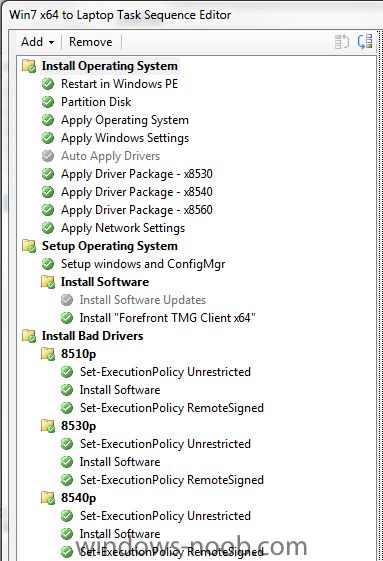Search the Community
Showing results for tags 'OSD'.
-
I have one machine that is giving us fits. No matter what we do, the machine won't image. When booting to PXE and after entering the PXE password it says that no Task Sequences are available for this computer. All my image jobs are deployed to All Systems and All Unknown Computers and every other machine works fine. Anyone seen this or have any ideas?
-
Hi, I have a problem with Boot Image on SCCM 12, I asked in Technet but nobody solve my problem, I need help for resolve my problem. This is link with my question in Technet: http://social.technet.microsoft.com/Forums/en-US/configmanagerosd/thread/6ae3e76e-f33a-4b5a-b3a3-f6e8878e7b3d/#c8128405-cc4b-47cd-997a-78b10b6807b6 Regards: Thiago Batista http://about.me/thiagitto
-
- boot image
- doesnt creat boot image
-
(and 4 more)
Tagged with:
-
We have over 100 remote sites connected with a 1.5mb connection. Currently, we use Zenworks for pc management. One feature we use is automatic re-imaging. When a remote computer needs to be re-imaged, we assign the task in zenworks. The computers are set to PXE boot first. When this job has been set, the pc boots, sees the task and completes it. This has been easy to reproduce with SCCM (We are migrating from Novell to Microsoft). The hard part is when the machine re-images, it applies the image from a second partition on the local hard drive. I can't figure out how to do this with SCCM. It takes too long to push the image over the network. Since we only have 3 to 5 users in each office, I can't justify a separate machine as a distribution point. Any help would be greatly appreciated.
-
Hi, I'm having an issue while trying to deploy Windows XP SP3 from a captured image to a computer using SCCM 2012. All my Windows 7 deployments work great, but this one is failing. The problem seems to be during the Apply device driver point. In my environment, I've created driver packages for each of my hardware models and per operating system. I then do some WMI filtering to apply them. What seems to be happening is that SCCM imports them with a GUID as the directory name in the driver package. When it applies the drivers for that model and modifies the OEMPNPDriverPath line in the Sysprep.inf file, it exceeds the magic 4096 character length. No matter what I do, I can seem to get past this. Any one have any ideas? The machines that I'm using are Dell computers and I'm using the Dell Cab files imported and packaged. Attached is my smsts.log file Thanks smsts.log
-
Now that I've got my PXE working I'm running into the error of: Failed to run task sequence because the program files cannot be located on a distribution point. In the documentation for RC2 it states to enable the "Copy content to a share on distribution points" but then after that it's vague on where it means when it says "Note: once you have enabled the setting above your Deployment distribution settings gets a new drop down menu choice, access content directly from a distribution point when needed by the running task sequence" Where can I find this and what exactly needs to be done here Disregard, I figured it out.
- 4 replies
-
- OSD
- Distribution Point
-
(and 1 more)
Tagged with:
-
Hey guys, I work for a school district with 13 campuses. We have a naming scheme that we use which is as follows: CAMPUS-SERIALNUM-T or -S The T designating a teacher machine and the -S designating a student machine. I have scripts that will name them correctly. What would be the easiest way to accomplish getting these named correctly during a mass imaging? Separate TS's for each campus? Separate Packages on the back end? Looking for your ideas. Thanks, Todd
-
Im able to install application with this line " Setup.exe /s /SMS /f1C:\HD\UTILS\Applications\2020\setup.iss /f2C:\HD\UTILS\Applications\2020\2020.log " as long as I run it manually or adveritise it, however when I executed during the OSD process fails because its not creating the log file . can someone please help me? Is there something wrong with my command.
-
Hi there. Looking for some advise regarding Windows 7 deployment & PXE Booting. Background - we are using sccm 2007 & mdt 2010, and are currently in the middle of a project to migrate our OS to Windows 7. We have a server (sccmbr01) which has been added as an sccm site-system, which contains the OS images & runs the WDS role; within sccm this is configured as a PXE Service Point. The server had been happily sitting on its own subnet, happily deploying OS images, and providing both DHCP & PXE services. However, Management have now, in their wisdom, decided to move this server onto the main ip subnet where our general server population are located. This still worked ok, as long as sccmbr01 was providing dhcp service, with the scope set to a single subnet unused by any other devices. Our problem at the moment is that we are looking to extend the OSD service - including PXE boot - throughout the organisation, so that we can perform "in situ" rebuilds & refreshes, etc. (estate - approx 5000 pcs, approx 200 subnets, many geographic locations etc). The Comms team want to configure this so that DHCP for PXE boot/OSD is provided by our regular domain DHCP servers - their argument is that if we extend the DHCP scopes provided by sccmbr01, the addresses will be used up by the general PC population, i.e., this will become just another regular DHCP server on the WAN. Comms have configured "ip helper" on the routers, etc; however, after several attempts, using different permutations, we have not been able to successfulyl PXE boot client. When sccmbr01 had dhcp active, the files/paths displayed after F12 network boot were as follows, in order of appearance \smsboot\x64\pxeboot.com \smsboot\boot.sdi \smsimages\smspkg\pr10022b\winpe.pr10022b.wim We have tried to configure the DHCP servers to point to the above files, without success. \smsboot\x64\pxeboot.com - launches "Windows Boot Manager" console, with the following error - "file - \bbot\bcd status - 0xc000000f info - an error occurred while attempting to read the boot configuration data" \smsboot\boot.sdi - displays error "too big to fit in memory" \smsimages\smspkg\pr10022b\winpe.pr10022b.wim - displays TFTP error When we leave DHCP unconfigured, using only IP Helper (this seems to be the recommended method), an error 53 (boot file not found) is displayed. Do you have any suggestions what we could try next, or something we may be missing? I found this thread which seems to be quite similar: http://www.windows-noob.com/forums/index.php?/topic/890-bootbcd-error/ Any suggestions would be gratefully sppreciated. Regards Stan
-
Deploy Applications on non-domain client with TS
Jasson posted a topic in Configuration Manager 2012
Hi, Dose anybody know that is that possible for me to deploy applications for those non-domain joined machines with OSD Task Sequence? Should I do some special configurations on SCCM2012 server? Because it always failed when the task sequence run the install application step if I didn't add the machine into domain at "Apply Network Settings" step. The funny thing is although I can't install the applications, I can successfully install the packages during the task sequences for those non-domain machines....- 2 replies
-
- OSD
- Task sequence
-
(and 1 more)
Tagged with:
-
Hi all, First and foremost, I love this site, it is such a fantastic reference guide and a boon to IT people like myself. I'm working on a new image, (actually, the same one I tweeted you about last week, Niall! As it turns out, we'd been using an incorrect NIC driver which was causing the port to take a long time to come online, and the PXE TFTP transfer was timing out as a result), for an HP 8560p Elitebook, and I've gotten it to boot through PXE to WinPE and get through the Apply Driver Package step of my Task Sequence. Install is Failing at Setup Windows and ConfigMgr with the following: -In setupact.log Now, I've looked through SCCM for the driver in accordance with directions found here: http://support.micro....com/kb/2012889 and I don't see this drive, oem79.inf. I decided to look further and discovered that the file in question is johci.inf, a 1394-Firewire driver, which I would not deem boot-critical, though evidently the installer believes this to be the case. I looked in SCCM and can't find a matching driver, but instead find many variants, all of which are signed. I then checked my boot image and this driver is not added to the boot.wim image either. So, before I disable and remove this driver from the Driver Packages for this model, do you guys have any thoughts? Thanks again for all of everyone's help.
-
Removed
-
- build and capture
- windows 7 64 bit
-
(and 1 more)
Tagged with:
-
Hi, I have a 50GB WIM file containing multiple Win7 images. Is there a way to have SCCM only download one particular image during OSD, and not the entire WIM file? Here is my problem: The machines I’m planning to image come with 160GB disks (actual size is 149 GB). The image I want to apply to them is 23GB and expands to 60GB. The last step in my Task Sequence is to perform a complete local backup using WBADMIN. So in the task sequence I define 2 partitions: C: - 89GB and D: - 60GB, apply the OS to C:, do some housekeeping, and then run WBADMIN to do a backup of C: to D. This works well when I use the 23GB capture WIM file. But when I use the 50GB WIM file into which I merged several images, there is no longer enough space to hold the 60 GB backup partition + the 50GB WIM file + the 60 GB to which the image expands on C:. Thanks, Edrik
-
Advertise a computer refresh.
rab414 posted a question in Deploying Windows 10, Windows 8.1, Windows 7 and more...
Hi, Having a bit of a problem refreshing a Win7 install by advert. I am trying to setup a TS that I can advertise to a machine that will basically restart the PC in PE environment, format the disk and install and OS. My TS is in the format of: Restart in Windows PE Format and Partition Disk Apply Operating System Apply Windows Settings Apply Network Settings Apply Driver Package Setup Operating System Setup windows and ConfigMgr Install Updates Restart Computer I’ve set the advert to go out at 11pm and the machine will pick it up. However, only thing that happens is the machine reboots, formats the disk and fails there. Anyone know what I’m missing or indeed if this is possible to do? Thanks for reading. Rob- 3 replies
-
- osd
- SCCM Advert
-
(and 1 more)
Tagged with:
-
Hey All, Just wondering how i can get the TS to prompt for a Computer Name during the OSD? I've already tried inputting the OSDComputerName Variable however when i input the value for the variable during the OSD or even if i leave it blank it still will not change the computer name. Any ideas? -Brendan
-
Hi, We are currently using SCCM 2007 R3 and the way that we use OSD is to create a virtual machine, build Windows 7 Enterprise on it, run all windows updates, install office 2010 and a few other utils that are standard to our builds and then capture it and run other programs (like Google Chrome etc..) from a task sequence. However, from time to time we need to update our base WIM file images, so what we do is to deploy the standard image (minus the task sequence programs) and then update the image, then re-capture it using the capture ISO. We then re-add the image on our server and go from there. This is not ideal as I believe that you can our capture a win 7 machine 3 times? so, after that, if we try and capture an image, it fails and we have to build an image from scratch again. I know there are other ways around this like snapshot our image once complete before capturing and then use that to update, or just having a windows 7 base image and deploy all software in the task sequence but I was wondering if there was any other advice anyone could give us about the best ways to update our windows images? Note that this is not just windows updates, but Autodesk DWG Trueview updates, java updates, flash updates etc... Thanks for your help in advance!
-
Greetings all, This is a great website! I am testing an implementation of SCCM2012 RC2 and all task sequences are failing regardless of what task I attempt. I've attached the log file from the pxe booted machine. From what I can tell, WinPE is unable to communicate with the MP (MNCMP.OTC.EDU). The test environment is running native mode. The machine is getting an IP address. Any thoughts? smsts.log
-
Hi, I'm trying to enable BitLocker during OSD but haven't had any success. I'm deploying Windows 7 x64 to an HP ProBook 6560B. I've enabled the TPM Chip within the BIOS and confirmed this is visible via the OS. As far as i'm aware we have not extended the schema within AD to allow for storage of keys, this isn't something we'll be doing and we don't wish to store any keys. I have selected the following options with the 'Enable BitLocker' TS: Current Operating System Drive - TPM Only Do Not Create A Recovery Key The TS fails with the following errors - Set command line: "OSDBitLocker.exe" /enable /wait:False /mode:TPM /pwd:None OSDBitLocker 11/01/2012 15:45:15 2712 (0x0A98) Target volume not specified, using current OS volume OSDBitLocker 11/01/2012 15:45:15 2712 (0x0A98) Current OS volume is 'C:' OSDBitLocker 11/01/2012 15:45:15 2712 (0x0A98) Succeeded loading resource DLL 'C:\Windows\SysWOW64\CCM\1033\TSRES.DLL' OSDBitLocker 11/01/2012 15:45:15 2712 (0x0A98) Protection is OFF OSDBitLocker 11/01/2012 15:45:15 2712 (0x0A98) Volume is fully decrypted OSDBitLocker 11/01/2012 15:45:15 2712 (0x0A98) Tpm is enabled OSDBitLocker 11/01/2012 15:45:16 2712 (0x0A98) Tpm is activated OSDBitLocker 11/01/2012 15:45:16 2712 (0x0A98) Tpm is not owned OSDBitLocker 11/01/2012 15:45:16 2712 (0x0A98) Tpm ownership is allowed OSDBitLocker 11/01/2012 15:45:16 2712 (0x0A98) uStatus == 0, HRESULT=80280012 (e:\nts_sms_fre\sms\framework\tscore\tpm.cpp,503) OSDBitLocker 11/01/2012 15:45:16 2712 (0x0A98) 'IsSrkAuthCompatible' failed (2150105106) OSDBitLocker 11/01/2012 15:45:16 2712 (0x0A98) Tpm does not have compatible SRK OSDBitLocker 11/01/2012 15:45:16 2712 (0x0A98) Tpm has EK pair OSDBitLocker 11/01/2012 15:45:16 2712 (0x0A98) Initial TPM state: 39 OSDBitLocker 11/01/2012 15:45:16 2712 (0x0A98) Creating TPM owner authorization value OSDBitLocker 11/01/2012 15:45:16 2712 (0x0A98) Succeeded loading resource DLL 'C:\Windows\SysWOW64\CCM\1033\TSRES.DLL' OSDBitLocker 11/01/2012 15:45:16 2712 (0x0A98) Taking ownership of TPM OSDBitLocker 11/01/2012 15:45:16 2712 (0x0A98) uStatus == 0, HRESULT=80070005 (e:\nts_sms_fre\sms\framework\tscore\tpm.cpp,645) OSDBitLocker 11/01/2012 15:45:18 2712 (0x0A98) 'TakeOwnership' failed (2147942405) OSDBitLocker 11/01/2012 15:45:18 2712 (0x0A98) pTpm->TakeOwnership( sOwnerAuth ), HRESULT=80070005 (e:\nts_sms_fre\sms\client\osdeployment\bitlocker\bitlocker.cpp,480) OSDBitLocker 11/01/2012 15:45:18 2712 (0x0A98) Failed to take ownership of TPM. Ensure that Active Directory permissions are properly configured Access is denied. (Error: 80070005; Source: Windows) OSDBitLocker 11/01/2012 15:45:18 2712 (0x0A98) InitializeTpm(), HRESULT=80070005 (e:\nts_sms_fre\sms\client\osdeployment\bitlocker\bitlocker.cpp,1191) OSDBitLocker 11/01/2012 15:45:18 2712 (0x0A98) ConfigureKeyProtection( keyMode, pwdMode, pszStartupKeyVolume ), HRESULT=80070005 (e:\nts_sms_fre\sms\client\osdeployment\bitlocker\bitlocker.cpp,1396) OSDBitLocker 11/01/2012 15:45:18 2712 (0x0A98) pBitLocker->Enable( argInfo.keyMode, argInfo.passwordMode, argInfo.sStartupKeyVolume, argInfo.bWait ), HRESULT=80070005 (e:\nts_sms_fre\sms\client\osdeployment\bitlocker\main.cpp,650) OSDBitLocker 11/01/2012 15:45:18 2712 (0x0A98) Process completed with exit code 2147942405 TSManager 11/01/2012 15:45:18 1800 (0x0708) !--------------------------------------------------------------------------------------------! TSManager 11/01/2012 15:45:18 1800 (0x0708) Failed to run the action: Enable BitLocker. Permissions on the requested may be configured incorrectly. Access is denied. (Error: 80070005; Source: Windows) TSManager 11/01/2012 15:45:18 1800 (0x0708) When i've tried to enable bitlocker from the command line (using manage-bde.exe -on C:) the output reports that BitLocker can't enable as TPM isn't the owner and that the OS needs to take ownership first. This can be achived by running manage-bde.exe -tpm -o selectapassword however i'm trying to avoid this method as would prefer to use the proper TS step (and have an auto generated password) Can anyone help? We're running SCCM 2007 R3.
-
Hi, We're trying to install IE9 as part of our OSD. This is software deployment step within the OSD TS as the original Windows 7 capture has IE8. When deploying a customised MSI (using the IEAK9) the installation completes fine however when the first user for the new machine comes to try logging on the following error is displayed: The User Profile Service service failed to start. The error is due to the following file located within the default user profile either being unreadable not accessable - C:\Users\Default\AppData\Local\Microsoft\Windows\Temporary Internet Files\SQM\iesqmdata_setup0.aqm Deleting the above file resolves the problem, similary changing the permissions the file also fixes the problem. Can anyone explain why this is happening and what resolution i can try? (I want to try to resolve the issue rather than adding a step to delete the file) This occurs on both x32 and x64 environments. I've also experienced the issue when deploying the same package to an existing Windows 7 machine that's already in use by a user. After the installation and reboot, the existing user can log on however no new users would be able to. Deploying an uncustomised IE does not cause this problem. Thanks, Doug
-
Hi All, I'm trying to do an OSD however when the machine im trying to do the deployment on as soon as the PC boots into the WinPE and when it gets to Starting Network section it reboots the PC once that's complete's. It doesn't seem to be seeing either of my Task Sequences nor is it prompting me for a password. Any ideas for what i can do to get this working?? Thanks, Brendan Thompson
-
Who cleared the PXE flag??
Christian1805 posted a question in Troubleshooting, Tools, Hints and Tips
Hi everybody! We have a SCCM 2007 R2 environment with nearly 20 secondary sites under 1 central site. Now it comes to security permissions delegations to the local admin at the local sites that they can do their Windows 7 Rollout. I created a security structure in SCCM with a flat hierarchie of groups in the AD. For the moment it works fine. A few days ago we had the situation that seems to clear all PXE flags to the "All Systems" collections. Many machiens that will get an OS over a Task Sequence were still in the OS Deployment collection (mandentory advertised), that means that these machine would have get a new OS after the next PXE request (default value!). In the end nothing happens, because we noticed that very fast. I just stopped our local WDS Service and deleted the direct membership of the machines in the OSD collections. Pig had I'm very scared about that, because the next time that happens we may be not so fast. The first question that I have: How can I figure out who deleted the PXE flag? I searched in several log files, queried the Status Messages, but nothing. Anybody knows where I can find that? The second interesting is: How can I prevent that a delegated user (also like everybody!) can clear the PXE flags on a completly collection?? (What also might be possible to use a script that the direct membership of the computers will be deleted after a successful OSD. I guess I saw somewhere a script like this...) Thanks in advance! Christian -
Still working on the SCCM 2012 test lab, and recently I added a driver package to the an OSD TS; I'd like to know if these drivers got properly installed and I don't know which logs to look into. Looks like during the OS deployment job the task sequence that is supposed to load the drivers (mainly DELL Optiplex drivers) runs properly, since I don't see any errors, but I just want to make sure since one set of drivers isn't getting installed. I'm assuming the client logs under windows\CCM\logs, but which file? Thanks!
-
Ok, I'm slightly confused (read: very). My environment is as follows (simplified). One primary SCCM server (SVR-SCCM) W2K8r2 with SCCM 2007r3 that is also the PXE server for our Main Office. This site has been doing OSD perfectly. One Remote site (SVR-SITE1) that has it's own subnet, DC (with DHCP), and is a BDP. The Boot Image has been successfully pushed to the remote site. I'm remotely PXE booting machines to do OSD. Here are my steps (simplified) 1) Boot remote computer 2) F12 for boot options 3) Choose "Boot from Onboard NIC" 4) F12 for Network Boot 5) Remote machine pulls wdsnbp.com from the PXE server (this takes about 10-15 minutes remotely) 6) Remote machine pulls boot.wim from PXE server (900 mb file, takes forever) 7) Brings up TS selection wizard Now, Step 6 is what I need assistance with. Am I able to have that boot.wim pull from my BDP? Or can that boot.wim ONLY be pulled from a PXE server? (This is the boot.wim that is in my ConfigMgr Admin Console under OSD->Boot Images.) I'm fairly certain that this should be pulling the boot.wim from the BDP, but I'm not sure. And if that is the case, what steps can I take to troubleshoot it and figure out why it is not pulling from the local BDP? TIA, Erik
- 1 reply
-
- branch distribution point
- OSD
-
(and 4 more)
Tagged with:
-
Hi everyone, Well, I've been a member of this forum for a short period of time, and I've asked way too many questions and gotten some good feedback from here and around the SCCM community. So, it's time for me to give back to the SCCM community. I modified a script that prompts for computer name as an OSD task is being performed. I've tested this script on a SCCM 2012 Beta 2 lab, and it's been working properly so far. Here's the link that explains how the script works as well as it shows the original owner and my modifications.
-
Hi I have question regarding some OS installations that are stuck in the running state long after the installation has finished. This is a problem for us because other software will not get installed unless the OSD has finished successfully. The final step in our OSD task sequence installs all software updates that are advertised. And I have selected to ignore errors in case they do occur. Because software updates will get install later on anyway (not preferred). But the problem is that when we are advertising more updates to a computer than are available on the DP. Reason might be that the updates are currently being staged or we have forgotten to stage them. And the installation waits until they are available. Is there a way to change the installation status from running to succeeded? Either by a registry hack or an sql query? Or to have a time out in the task sequence causing it to "fail" which is ok because it's the last step. I have found the following key in the registry and someone here pointed out that if you want to rerun an advertisement that has the option rerun failed advertisements you can change it from succeeded or exit code 0 to exit 1 or whatever and the installation will restart next policy refresh. HKLM>Software>Microsoft>SMS>Mobile Client>Software Distribution>Execution History>System>"advID".
-
- osd
- software updates
-
(and 2 more)
Tagged with:
-
Hi, I am currently deploying machines over 802.1x network and am using user authentication to achieve this, however I found one problem. The computer being deployed does not retrieve machine certificate until sometime after the OSD has finished. I have created a vbscript that creates an inf file (putting the hostname into the inf file). Then I use certreq to create the request, submit and accept cert from the enterprise CA. This is all done in my win7 deployment task sequence while in current OS (not Winpe). I have tested this on a computer that has been deployed and it works fine. However during the OSD I get this error: Error title: Certificate Request Processor "The requested resource is in use. 0x800700aa (WIN32/HTTP: 170) machine.inf([NewRequest] Subject ( "CN=testcomputer.mydomain.com")" If I skip this step I am always needed to run a fix after each OSD where I change the authentication mode from user to Machine (802.1x). Any idea on what could be wrong? How are others doing this? GauiC
-
- Certificate
- OSD
-
(and 1 more)
Tagged with:







